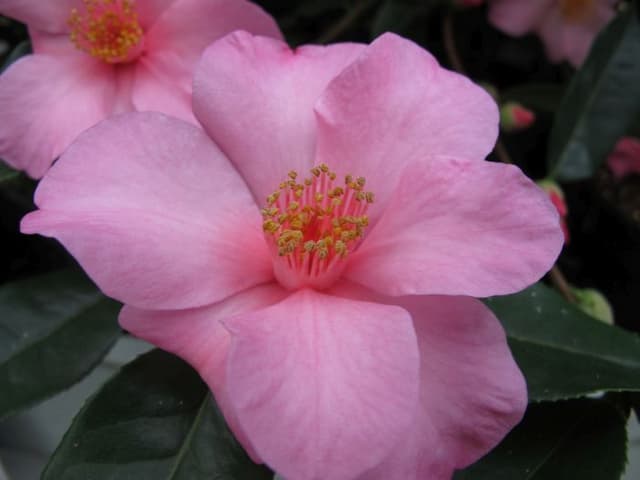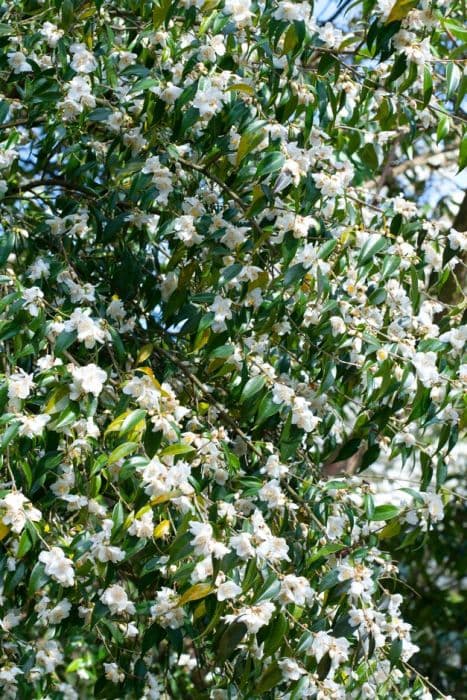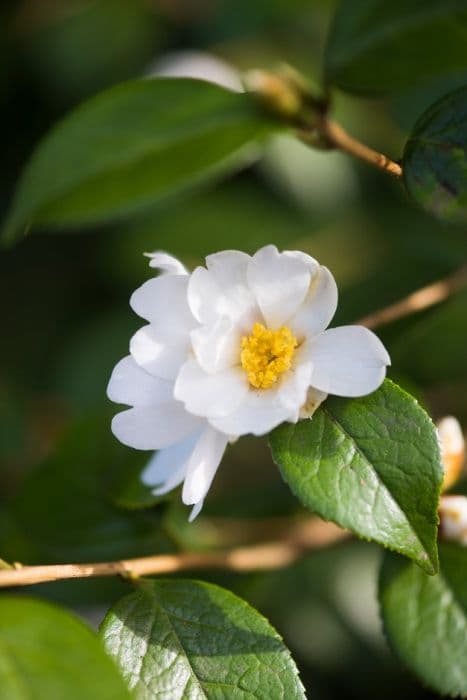Camellia Camellia 'Royalty' (japonica × reticulata)

ABOUT
Camellia 'Royalty' is a stunning hybrid featuring large, opulent flowers that draw immediate attention. The blossoms boast a rich, deep pink hue, and their form is exquisite, characterized as formal double flowers where multiple layers of sumptuous petals are perfectly arranged in a symmetrical pattern. This grand display of floral beauty emerges from glossy, dark green leaves that provide a dense and lush backdrop for the showy blooms. The leaves have a leathery texture and an ovate shape with serrated edges, which accentuate the plant's overall elegance. Flowering typically occurs during the late winter to spring, providing a burst of color in the garden when many other plants remain dormant. The Camellia 'Royalty' exudes an aristocratic charm, living up to its name and making it a prized specimen for plant enthusiasts and gardeners looking to add a touch of regal splendor to their landscape.
About this plant
 Names
NamesFamily
Theaceae
Synonyms
Japanese Camellia, Rose of Winter
Common names
Camellia 'Royalty' (japonica × reticulata)
 Toxicity
ToxicityTo humans
The Camellia 'Royalty', often just referred to as Camellia, is generally considered to be non-toxic to humans. There are no well-documented cases or significant evidence that suggests the ingestion of Camellia leads to poisoning in humans. Therefore, accidental ingestion of this plant's parts typically does not result in symptoms of poisoning or serious consequences.
To pets
The Camellia 'Royalty', commonly known simply as Camellia, is generally considered to be non-toxic to pets as well. It is not known to cause any significant toxic reactions in animals such as cats and dogs if they happen to ingest parts of the plant. Consequently, there are no specific symptoms of poisoning associated with the Camellia in pets, and ingesting this plant is not expected to result in serious health issues for them.
 Characteristics
CharacteristicsLife cycle
Perennials
Foliage type
Evergreen
Color of leaves
Green
Flower color
Pink
Height
6-10 feet (1.8-3 meters)
Spread
6-10 feet (1.8-3 meters)
Plant type
Shrub
Hardiness zones
7-9
Native area
East Asia
Benefits
 General Benefits
General Benefits- Ornamental Appeal: With its large, showy flowers, the Camellia 'Royalty' adds visual interest and aesthetic value to gardens and landscapes.
- Long Blooming Season: This plant typically has a lengthy blooming period, providing color and beauty throughout the season.
- Evergreen Foliage: The Camellia 'Royalty' maintains green leaves year-round, offering constant foliage coverage and structure in gardens.
- Drought Tolerance: Once established, it can tolerate periods of dryness, making it suitable for climates with occasional water shortages.
- Shade Tolerance: It can grow successfully in partially shaded areas, providing flexibility in garden placement and design.
- Cold Resistance: This hybrid is relatively resilient to cooler temperatures compared to some other ornamental plants.
- Wildlife Attraction: Its flowers can attract pollinators, such as bees and butterflies, enhancing the biodiversity of the area.
- Low Maintenance: With minimal pruning and care requirements, Camellia 'Royalty' is user-friendly for gardeners of all levels.
 Medical Properties
Medical PropertiesThis plant is not used for medical purposes.
 Air-purifying Qualities
Air-purifying QualitiesThis plant is not specifically known for air purifying qualities.
 Other Uses
Other Uses- Artistic inspiration: The Camellia's vibrant flowers and contrasting dark green foliage can inspire artists and photographers looking for striking natural subjects.
- Education and research: Botany students and researchers can study the Camellia's hybrid characteristics and breeding methods as an example of plant genetics and horticultural practices.
- Culinary decoration: The petals of Camellias can be used as an elegant, non-toxic garnish for salads and desserts to add a splash of color.
- Dye production: The petals and leaves of the Camellia plant can be used to create natural dyes for fabrics, yarns, and artisanal crafts.
- Handcrafting: Dried Camellia petals and leaves can be used in potpourri, bookmarks, or as inclusions in handmade paper for a unique texture and appearance.
- Floral competitions: Camellia enthusiasts may cultivate the 'Royalty' variety for entry in flower shows and competitions due to its distinctive blooms.
- Cultural ceremonies: In some cultures, Camellias are used as symbols during festivities or rituals to represent ideals such as purity and longevity.
- Landscape design teaching: The Camellia can be utilized in educational settings to demonstrate principles of landscape design, including color balance and focal points.
- Ice cubes for events: Freeze Camellia petals in ice cubes to create visually stunning additions to beverages for weddings or special events.
- Bath and body products: While excluding medical properties, Camellia petals can be infused into bath salts or soaps purely for their fragrance and aesthetic appeal.
Interesting Facts
 Feng Shui
Feng ShuiCamellias are associated with adoration, perfection, and refinement in Feng Shui. They are believed to attract positive energy when placed in the southwest area of a garden or home, which corresponds to love and marriage in the Bagua map, possibly enhancing relationships.
 Zodiac Sign Compitability
Zodiac Sign CompitabilityThe Camellia is not used in astrology practice.
 Plant Symbolism
Plant Symbolism- Admiration - Camellias often symbolize deep admiration for someone, making them a favorite to give to those we respect or hold in high esteem.
- Perfection - With their perfect, intricate petals, camellias can represent the ideal of perfection or excellence.
- Love and Affection - Camellias, like many flowers, can be a symbol of love and affection towards someone, with different colors conveying different emotional tones.
- Longevity and Faithfulness - The camellia's ability to bloom for a long time makes it a symbol of longevity and faithfulness in relationships.
- Gratitude - Giving camellias can also express gratitude, illustrating a sense of thankfulness to another person.
 Water
WaterCamellias require consistent moisture but do not tolerate waterlogged soil. Water the Royal Camellia thoroughly when the top inch of soil feels dry, generally once a week. Use approximately one to two gallons of water per plant for each watering session to ensure deep soil penetration, which helps to encourage a robust root system. During hot or dry spells, water twice a week. Be cautious of overwatering, as it can lead to root rot.
 Light
LightThe Royal Camellia prefers partial shade to filtered sunlight. It thrives in a spot that offers protection from the hot afternoon sun, which can scorch the foliage. Ideally, provide morning sunlight with dappled or partial shade in the afternoon to maintain vibrant bloom color and plant health.
 Temperature
TemperatureCamellia 'Royalty' can survive temperatures as low as 15 to 20 degrees Fahrenheit and as high as 85 degrees Fahrenheit. However, the ideal temperature range for fostering growth and blooms is between 60 and 70 degrees Fahrenheit. Protect the plant from extreme cold by providing mulch or shelter when temperatures are forecasted to drop near the minimum threshold.
 Pruning
PruningPrune Royal Camellias to maintain shape, remove dead or weak growth, and encourage vibrant blooms. The best time to prune is immediately after flowering, but before new growth begins, to avoid cutting off next season's buds. Pruning once a year is often sufficient, carefully selecting and removing branches to create an open, healthy canopy.
 Cleaning
CleaningAs needed
 Soil
SoilFor the best soil mix for Camellia 'Royalty', use a well-draining acidic soil with a pH between 5.5 and 6.5. Incorporate organic matter such as peat moss or finely ground pine bark to enhance soil structure and fertility. A mix specifically targeted for azaleas or camellias would also be suitable for this plant.
 Repotting
RepottingCamellia 'Royalty' should be repotted every 2-3 years to ensure healthy growth. This practice allows you to refresh the soil and increase pot size as needed to accommodate the root system. It is best done in late winter or early spring before new growth begins.
 Humidity & Misting
Humidity & MistingCamellia 'Royalty' prefers high humidity, ideally between 50-60%. To create a suitable environment, you may need to use a humidifier or place the plant on a water-filled pebble tray to maintain these humidity levels, especially during dry winter months when indoor heating can reduce indoor humidity.
 Suitable locations
Suitable locationsIndoor
Place Camellia 'Royalty' near a window with filtered light and ensure high humidity.
Outdoor
Plant Camellia 'Royalty' in partial shade with shelter from strong winds.
Hardiness zone
7-9 USDA
 Life cycle
Life cycleThe Camellia 'Royalty', commonly known as a hybrid camellia, begins its life when a seed germinates, typically in a warm and moist environment, leading to the emergence of a radicle followed by the plumule. The seedling stage involves growth into a young plant with true leaves, at which point it can be transplanted into the garden or a more permanent location. As it enters the vegetative stage, the plant develops a strong root system and numerous leaves, preparing for future flowering. Following the vegetative stage, the camellia matures into the flowering stage, characterized by the production of large, showy flowers that can be red, pink, or a combination of these colors, typically blooming in the winter or early spring. The pollination of these flowers, either by insects or through human assistance, can result in the formation of seeds, thus completing the reproductive cycle. Eventually, as the plant ages, it reaches the senescence stage, during which growth slows down, leaves may yellow, and it becomes less vigorous until it ultimately dies.
 Propogation
PropogationPropogation time
Spring-Early Summer
Camellia 'Royalty', commonly known as Camellia, is best propagated during late winter to early spring. The most popular method is semi-hardwood cuttings. For this process, select healthy, semi-hardwood stems from the current year's growth. These cuttings should be about 4 to 6 inches long (10 to 15 centimeters) and contain several leaf nodes. Dip the cut end into a rooting hormone to increase the chances of successful rooting. Plant the cuttings in a well-draining potting mix, ensuring at least two leaf nodes are beneath the soil surface. High humidity, consistent moisture, and a temperature of about 70 to 75 degrees Fahrenheit (21 to 24 degrees Celsius) will provide an ideal environment for root development.









